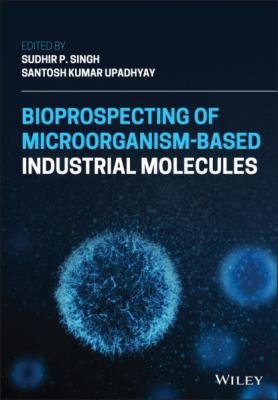Bioprospecting of Microorganism-Based Industrial Molecules. Группа авторов
Читать онлайн.| Название | Bioprospecting of Microorganism-Based Industrial Molecules |
|---|---|
| Автор произведения | Группа авторов |
| Жанр | Биология |
| Серия | |
| Издательство | Биология |
| Год выпуска | 0 |
| isbn | 9781119717263 |
Table 4.2 Algal biomolecules, sources, origins, and applications in cosmetics.
Source: Wang et al. [85] and Wang et al. [86].
| Group of compound | Active compound | Algal species | Cosmetic properties | References |
|---|---|---|---|---|
| Polysaccharides | Agar | Gelidium sp.Gracilaria sp. | Emulsion stabilizers, gelling agents, thickeners | [87–89] |
| Alginates | Laminaria sp.Lessonia sp.Macrocystis sp. | Emulsion stabilizers, chelating agents, gelling, moisturizing, photo‐protective | [8490–92] | |
| Fucoidan | Saccharina sculpera Fucus vesiculosus, Turbinariaconoides, Undaria pinnatifida | Antiaging, anti‐wrinkle, antioxidative properties, UV protectant, skin lightening, spot reduction, elastase, tyrosinase inhibitors, skin fibroblast stimulation | [93–97] | |
| Laminarans | Laminaria japonica, Ecklonia kurome, Eiseniabicyclis, Saccharina, Ascophyllum, Fucus, Sargassum, and Undaria | Antioxidant, anti‐cellulite agent | [81, 98, 99] | |
| Porphyran | Porphyra sp. | Antioxidant and antiaging | [78, 88, 93, 100] | |
| Carrageenan | Acanthophora muscoidesChondrus crispus | Gelling agents, protective colloids, thickeners | [101–103] | |
| Ulvan | Ulva armoricana, Ulva lactuca, Ulva rotundata, and Ulva rigida | Antioxidative, chelating, gelling, moisturizing, and protective agents | [88, 104, 105] | |
| Pigments | Astaxanthin | Haematococcus pluvialis | Antiaging | [106] |
| β‐carotene | Chlorella, Spirulina, Dunaliella salina | Antiaging, antioxidant, radical scavengers, anti‐photoaging agents, and colorants | [88107–111] | |
| Chlorophylls(a, b, c, d) | Chlorella, Nannochloropsis | Coloring agents, UV‐protectant, reduce inflammation, Reducing wrinkles, inhibiting matrix metalloproteinases (MMPs) | [88, 92,112–114] | |
| Fucoxanthin | Fucus, Dictyota, Saragassum, and Laminaria | Anti‐tyrosinase activity in guinea pig UVB irradiated, and melanogenesis in mice UVB irradiated | [88115–117] | |
| Phycobiliproteins(APC, PE, PC) | Cyanobacteria | Antioxidant, anti‐inflammatory, colorants, radical scavenging agents | [88, 97,118–121] | |
| Secondary metabolites | Phlorotannins | Ecklonia cava, Eiseniabicyclis | Tyrosinase and hyaluronidase inhibitors, antioxidants, antiaging, UV‐photoprotectant, chelating agents | [79, 88, 122] |
| Mycosporine‐like amino acids (MAAs) | Scytonemin, Asterina‐330, Shinorine, PalythinePorphyra‐334 | Scytonema, Lyngbya, Porphyra umbilicalis | Photo‐protectant, sunscreen against UV‐A | [79, 111,122–124] |
4.4.4.2 Fucoidan
Fucoidans are heteropolysaccharides containing L‐fucose sugar and sulfate ester groups [10]. They are mostly derived from the brown seaweed. In some seaweeds, along with fucose sugar, other sugars such as glucose, galactose, mannose, xylose, and glucuronic acid (GlcA) have also been reported [125]. The application of fucoidans in the cosmetic industry has been widely investigated. Numerous study has been carried on the inhibitory aspects of topical application of fucoidans on the skin against aging and photo‐damaged effects [93, 94, 115]. Fucoidans are known to enhance multiplication skin fibroblast and augment the retention of native collagen [95, 126]. Fucoidans are known to protect the elastic fiber network in human dermal cells, and hence they are used as a natural whitening agent in lotion and skin creams to reduce age spot and increased radiance, increase smooth texture skin [96, 127]. In human skin, melanocytes cells are known to impart the skin complexion. The pigment melanin is produced and stored inside the melanocytes and is primarily obtained from amino acid L‐tyrosine, which is converted to dopaquinone by the action of the enzyme tyrosinase. Hence, suppression of tyrosinase‐related proteins plays an important role in anti‐melanogenesis and skin whitening [128]. In this regard, several studies have demonstrated the inhibition of enzyme tyrosinase, antioxidant activity, and anti‐melanogenesis of fucoidan fraction from various macroalgae [96, 128, 129]. Furthermore, the property of fucoidans to readily solubilize in water makes it attractive to combine into several ranges of cosmetic formulations such as lotions, creams, ointments, and other beauty products.
4.4.4.3 Laminaran
Laminaran is also widely known as laminarin or leucosin. Laminarin is a glucan polysaccharide made up of β(1→3)‐glucan with β(1→6)‐branches with a β(1→3):β(1→6) in the ratio of 3:1. They are obtained from brown seaweeds Laminaria japonica, E. kurome, Eiseniabicyclis, Saccharina, Ascophyllum, Fucus, Sargassum, and Undaria species. Several reports have confirmed to have anticancerous, anti‐inflammatory, anticoagulant, and antioxidant properties in laminarin extracts of seaweeds [87]. Laminarin is widely used as filler composition in cosmetic products for the treatment of wrinkles, folds, and as anti‐cellulite agents [98, 99].
4.4.4.4 Ulvans
Ulvans are cell wall polysaccharide derived from the genus Ulva (Ulvaarmoricana, Ulvalactuca, Ulvarotundata, and Ulvarigida) of green macroalgae belonging to the Chlorophyta group. Ulvan roughly contributes from 9 to 36% dry
